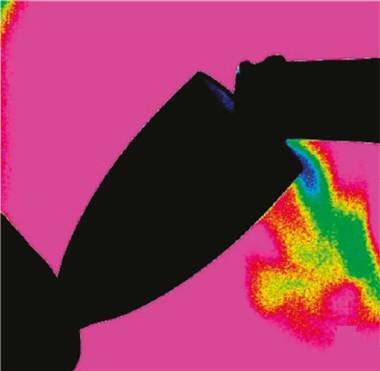On the MSNBC site on the web today I found a piece of science that is important for every drinker of champagne. Scientifically, what is the best way to pour champagne and why?
The picture above is a false-colored infrared video shows carbon dioxide emanating from a champagne glass while the bubbly is being poured from a bottle stored at 64 degrees Fahrenheit. Looking at different glass angles and different temperatures, French scientists have found the right combination.
The bubbles in bubbly are carbon dioxide, common CO2. You want the CO2 to reach your mouth. The release from the liquid champagne of the carbon dioxide in your mouth is what provides that wonderful tingle. You want the carbon dioxide to reach your mouth, not dissipate too much in the glass.
Pouring the champagne straight down to the bottom of the champagne flute releases too much of the carbon dioxide, literally wasting it before you can enjoy it. Pouring the champagne gently down the side of the glass reduces the release of the carbon dioxide. The loss of CO2 can be twice as much in straight-to-the-bottom pour versus a slide-down-the-side pour.
Temperature is also important with CO2 loss minimized if the champagne is stored at 39°F. Served at a higher temperature, say a balmy 64°F, and those bubbles are lost before they reach your mouth.
These studies were conducted by French scientist Gerard Liger-Belair and his colleagues at the University of Reims. They found that smaller bubbles are better: each bubble picks up flavor and aroma molecules as they rise in the glass; when the bubbles hit the top, they release scent and flavor. The scientists found that more, small bubbles did a better job than fewer, large bubbles in this culinary transition. Bubble size is dependent on many factors including the chemistry of the bottle contents: what salts, carbohydrates and minerals are dissolved in that liquid. That is why champagne bubbles will necessarily differ from those in another sparkling wine, say Cava, that comes for a different terroir. It’s chemistry.
The MSNBC web article includes this information:
“Liger-Belair’s team listed some other ways to control how your sparkling wine sparkles after you’ve poured it into the glass. They found that more bubbles are sparked if there are minute fibers or scratches in the glass. Thus, older, scratched-up glasses release bubbles more quickly than newer, slicker glasses.
“If you want bubblier champagne in the glass, you can try wiping the flutes vigorously with a towel to leave some fibers behind. If you want to tone down the bubbles (and let them pop on your palate instead), wash the flutes and let them air-dry on a rack, sans toweling.
“This time around, Liger-Belair and his colleagues took an up-close look at how champagne bubbles are created. The research team confirmed that most of the bubbles begin with minute cylindrical cellulose fibers deposited on the glasses by air currents, or by towel-drying. That brings us to the advice on strategy:
- If you want bubblier champagne, wipe the inside of the glasses vigorously with a towel before pouring.
- If you want to tone down the bubbles, wash your glasses, then let them air-dry upside down on a rack, without using a towel.
“Minute scratches on the glass also promote bubble nucleation – with the implication that wine may be bubblier in older glasses than in newer ones. In fact, some glassmakers intentionally make microscratches in their champagne flutes to create bubbly special effects.
“The focus of this most recent research has to do with why some ‘bubble trains’ in champagne move gracefully, with bubbles popping up at regular intervals, while other bubble trains stream less evenly.
“The researchers’ microscopic examination found that it had to do with precisely how the carbon dioxide is trapped within those tiny fibers, and how the gas bubbles interact with each other. Variations in the properties of the fibers – such as size, irregularities in the fiber’s inner wall and the diameter of the fiber’s ‘sleeve’ – can introduce instability in the bubble trains, they said.”
Source: MSNBC website on 12/29/2010

